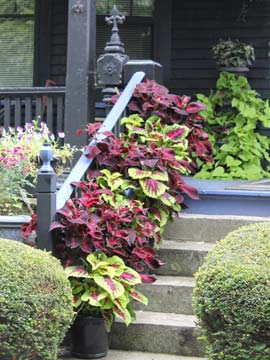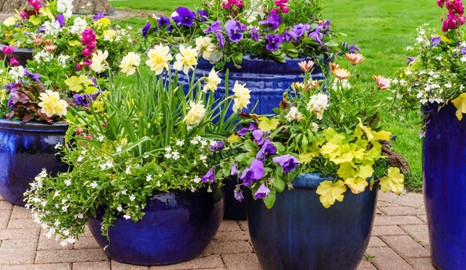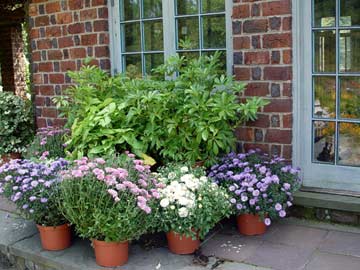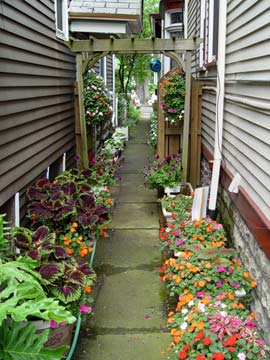Take your yard to a new level by landscaping with potted plants
 Using just one type of plant per pot is a simple but elegant way to landscape with containers.
Using just one type of plant per pot is a simple but elegant way to landscape with containers.
© George Weigel
Growing plants in containers is gaining steam not only because it’s easier than tending plants in the ground but also because of the growing number of gardeners with little to no open ground in the first place. A generation ago, container gardening amounted to little more than setting out a pot of red geraniums with a spike plant next to the front door. These days, gardeners are more likely to trade beds full of 6-pack annual flowers for several pots filled with diverse and cutting-edge flowers. The trend even comes with a new name – "containerscaping." Sometimes called "potscaping," containerscaping is a hybrid buzzword for landscaping with container plants.

In addition to creating what are essentially “pot gardens” on decks and patios, it includes placing pots in opportune spots throughout the yard. The idea isn’t new, but the containerscaping term has popped up as some garden centers have begun offering the service of designing and installing flower pots for their customers. Whatever you call it, the main attraction is that it offers a fairly easy way to add color to a home’s exterior without digging, weeding and battling the bunnies. It’s certainly less labor-intensive than planting landscape beds full of annual flowers, which fewer people do because of the work, expense and shrinking yard sizes. Containerscaping gives an in-between option.
 Arrange potted plants the same way you'd arrange plants in a garden for a "landscapey" look to a pot garden.
Arrange potted plants the same way you'd arrange plants in a garden for a "landscapey" look to a pot garden.
© George Weigel
Planting, watering and fertilizing a group or two of pots takes more effort than one big geranium pot, but it gives comparable impact to masses of in-ground flowers with significantly less work. In its simplest form, a containerscape can be a triangle of three pots. For unity’s sake, use two sizes of the same pot – two bigger ones in the back of one smaller one or one bigger one behind two smaller ones.
Another way to tie the grouping together in a “landscapey” way is by picking a theme color and repeating it in all three pots. An example is planting in shades of red, including a range of flowers from pale pink to medium pink to rose to rosy-red. Or you could use one particular plant as a unifying element in all of the pots. White euphorbia or begonia ‘Dragon Wing,’ for example, could be the theme plant in each pot with different partners in the different pots. If you’re up for more than three pots per group, add as many as space permits. Keep in mind that odd numbers tend to look more natural than even numbers (five or seven pots instead of four or six), and that your layout should keep the bigger pots and plants toward the back of the prevailing view.
Most people tend to automatically plant several plants in each container because that’s “just the way you do it.” That’s not necessarily the case when containerscaping in clusters. An elegant alternative is to use one variety of plant in each pot, then arrange the pots so the sizes, forms and textures look good with one another. It’s similar to how you’d arrange blocks or masses of different plants in an in-ground garden. A side benefit of planting in pot clusters is that it reduces water loss – at least in the pots shielded by the outer-perimeter ones bearing the brunt of the hot, summer wind.
 Clusters of pots give color and life to an all-concrete walkway that otherwise would be barren.
Clusters of pots give color and life to an all-concrete walkway that otherwise would be barren.
© George Weigel
To aid with watering, rig up an automatic drip-irrigation system and connect the pots with skinny tubing fitted with emitters in each pot. This will eliminate buckets, cans and hoses and solve the leading reason for pot failure – missed waterings.
A second care issue is keeping potted plants fertilized. Frequent watering leaches nutrients out of the root zone, which means fertilizer application is needed more often than with in-ground plants.
A few other containerscaping possibilities:
- Out in the yard, a colorful pot or three can make interesting focal points at key spots in gardens. Elevate them on blocks to stand above the crowd.
- Set pots over bare spots in the landscape, such as where the spring bulbs died back or the cool-preferring spring ephemerals have gone dormant.
- Flank any doorway, arbor or entry with a pair of eye-grabbing flower pots to serve as “sentinels.”
- Erect trellis behind a vine in a pot to let it add color to a bare wall that abuts a hard surface.
- Trouble getting plants to grow in the root competition of a big tree? Just mulch the surface and grow your underplantings in pots.